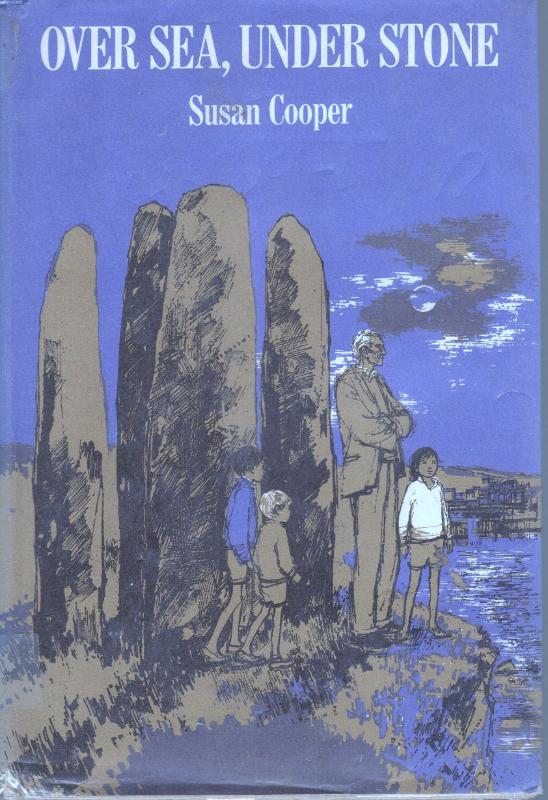Over Sea, Under Stone, the first book in Susan Cooper’s The Dark is Rising series, opens slowly, almost leisurely, with no hint of magic at all. Rather, it tells the story of three children, Simon, Jane and Barney, who arrive at a mysterious house (complete with one of those marvelous housekeepers who only seem to exist in English literature). Naturally, they begin exploring, and equally naturally, they soon find a mysterious room and a mysterious treasure map that takes some time to decode. And they begin to suspect that not all is quite normal with their supposed Great Uncle Merry (often called Gumerry), not to mention the overly friendly neighbors offering boat rides and that housekeeper with her marvelous food.
With its hunt for mysterious treasure, grizzled, quaint and friendly townsfolk, friendly housekeepers who insist on loading up children with far too much picnic food, a surly and unhelpful local boy, and even a cute dog, it initially comes off rather like a Famous Five novel (a popular children’s adventure British book series), only better written. But midway through, the novel begins to switch to something else, offering hints of magic and fantasy, and very real danger. (And also a very, very bad example of WHAT NOT TO DO when the tide on a rocky coastline goes out. Kids, don’t do this. I was frankly expecting more injuries from the ocean than from the bad guys. But moving on.)
As the kids discover, the treasure they are seeking is actually the Holy Grail. Not the Monty Python version, but an object of power, carried away and hidden by an old knight, who for some reason then felt compelled to leave detailed instructions on how to find it, assuming, of course, that the seeker is standing in just the right place with just the right time with a nice cooperative tide. (Again, kids, don’t do this.) And it is this discovery which slowly changes their adventure from light hearted fun to something far more important, and far more real—and unreal. For, as it turns out, Great Uncle Merry is a bit more than he seems, and those two seemingly friendly visitors and that excellent cook and housekeeper have not exactly been fully forthcoming either.
Cooper doesn’t bother to give the three kids particularly distinct personalities, making them slightly difficult to distinguish in the beginning of the book, until some dialogue slowly establishes that Simon is the eldest, with a tendency to be a bit bossy and brag about his Latin, Jane is a girl, and Barney likes to read, but is still young enough to play cute and innocent with adults. Otherwise, all are pretty much perky and brave, although Jane, sigh, breaks down a bit more than the boys, even though she’s older than her brothers. And, of course, she’s the one to carry a clean handkerchief and keep her pockets clean. But she does eventually lose her hair ribbon, so, plus, and she does help solve the mystery—she is the one to realize how they have to interpret the images on the map. If she’s also the person who helps let the bad guys know what’s going on—well, she isn’t the only one. And at that, she’s an improvement from her female counterparts in the Famous Five novels.
Cooper also cheats a little by having her wise, mentor Merlin figure actually turn out to be Merlin, which, okay, nice touch, and which also allows her to bypass any claims that she hasn’t exactly created a new take on the old sorcerer-mentor figure here. Not that the character does that much magic in this book—just enough, with his name, to clue alert readers into his real identity.
But characterization aside, this is a fun, quick read, with a mystery to investigate and an adventure to follow. And although Cooper hints at more things to come in the last few pages, the novel stands fine on its own—you can end the series easily enough here, although doing so also means you’ll miss the main point—and the later highlights —of the series.
Nonetheless, although I generally recommend starting at the beginnings of series, I’m not sure I can do so here. Mostly because this is very different from the rest of the series—somewhat, I suppose, like reading The Hobbit and then immediately moving onto The Return of the King, without all the comforting hobbit stuff at the beginning of Fellowship of the Ring to help you with the transition. It might be better read alone as a standalone book, or read after the rest of the series, when you are wondering just how Simon, Jane, and Barney got involved in all of this in the first place. Otherwise, you can easily start with The Dark Is Rising (the second book of the series) and encounter Simon, Jane and Barney in the third book, Greenwitch.
Mari Ness likes to watch tides go in and out. She lives in central Florida.










